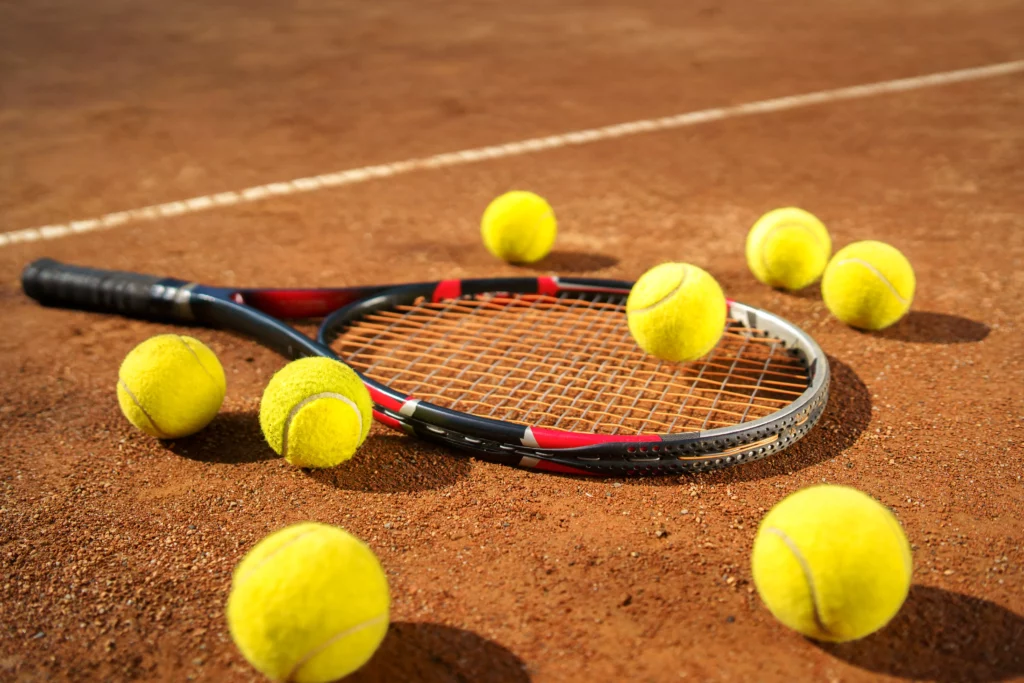5 Reasons Why Weightlifting Will Improve Your Tennis Game

Since our attention is drawn away from the China Open after Andy Murray’s defeat to Dominic Thiem in the Quarter Finals, we probably need an uplifting blog post about tennis and how you can improve your game. Specifically, this post will identify 5 reasons why incorporating weightlifting into your fitness routine will improve your ability and why. By the end of this blog, we hope that you will have been convinced on the importance of weight training and its relevance in the sport of tennis. Throughout this post, exercise examples with pictures will be provided so that you can add these into your workout routine to start seeing the results on the court!
Many years ago, weight training was undervalued within the sporting world. Tennis players use to increase their fitness by cramming as many tennis matches into their day as possible. Nowadays, tennis players spend just as much time in the gym as they do out on the court! The reasons for this are simple. The muscles in our body act as active stabilisers for our joints as well as making up our core strength and stability. When these muscles are activated, the resulting stability forms the foundation for all movements, which when recruited in movement patterns leads to functional movements, such as a tennis serve. The stronger these muscles are, the greater the strength, speed, stability, power and endurance they have.
Below are the 5 main reasons why we believe you should incorporate weight training into your routine:
- Injury prevention: with tennis placing great increases in stress and load on our muscles and joints, it is imperative that we facilitate our body to be able to withstand these increased stresses. For example, the repetitive nature of tennis serves commonly leads to shoulder pain, particularly rotator cuff injuries. Knee pain is a common injury within tennis due to the repetitive nature of jumping to initiate a serve, this commonly leads to patella tendinopathy, frequently referred to as Jumper’s knee. The fast paced repetitive multi-directional nature of tennis frequently lead to ankle sprains. You may have noticed a common word throughout this paragraph, repetitive, a bit about this – sports injuries are classified as overuse or traumatic injuries. For example, in rugby, traumatic injuries such as ACL ruptures and shoulder dislocations are common from the contact nature of the sport. In tennis, overuse injuries are common due to the highly repetitive nature of the sport, whereby you use the same muscles consistently over extended periods of time. So how does weightlifting help prevent these common tennis injuries? Well, without boring you with the gory details, stronger muscles around the joints ensure greater stability and resilience against the high impact that is involved with hitting the ball as well as the constant twisting, rotating, multi-directional stop and start motions on the court.
- Serve speed: it is a common myth that to improve your tennis serve speed you only need to improve your upper limb strength capability. Serve speed and accuracy is all about serve technique and form, particularly the ‘coiling’ and ‘uncoiling’ movements of the serve. If you aren’t aware of this coiling technique, I’d highly recommend reading up on this. In this uncoiling action, the aim is to hit the tennis ball the same way as power is unleashed at the tail end of a whip. Powerful lower limb muscles play a huge factor in this, during the first phase of the coiling action, our knees are bent, the greater this knee bend is, the greater the vertical explosive force we can propel through our legs into the shot, which will increase your tennis serve speed. Of course, we need strong upper limb muscles for tennis serves also, particularly around the shoulder and rotator cuff to improve our shoulder stability and ability to produce rotatory force.
- Muscular endurance: contrary to popular belief, there are many other forms of muscle capability other than muscle strength and tennis is the perfect sport to highlight these differing capabilities. Muscles can be and should be trained in different frequencies and intensities dependent upon whether you want to train your muscular endurance, power or strength. As explained in the previous paragraph, you need muscle power for explosive movements such as jumping up to meet the tennis ball for the serve. You need muscle strength to act as active stabilisers for our joints and enhance our ability to produce functional force. You also need muscular endurance, which is often the most understated and undertrained. As tennis rallies can be over quicker than the 100m sprint but tennis matches can last longer than a marathon, it is clear to see how muscular endurance is a key component for tennis players. As you near the end of your tennis match, your muscles become fatigued and build up with waste products, which both reduce your performance and increase your risk of injury. If you build your muscular endurance, you give yourself the fighting chance to outlast your opponent. So, how do you train muscular endurance? Guidelines state that you should lift 40-60% of your 1 rep max, complete 15-25 repetitions, 3-5 sets, with a moderate/fast lifting speed and integrate 2-4 endurance based exercises into your weekly workout.
- Core stability: a strong stable core is integral for dynamic functional movements such as you will perform whilst playing tennis. Your core is the lumbar-pelvic-hip complex, which is where numerous muscles originate and attach to and allows the transfer of forces through the body. The abdominals, obliques, glutes and lower back muscles are extensively used for the most important shots in tennis – the serve, forehand and backhand.
- Metabolic: weight training not only has benefits for your muscular system, it also has cardiovascular, hormonal and metabolic benefits. The more muscle you have, the higher your metabolic rate will be, as muscles burns more calories per day than the fat equivalent. Therefore, weight training is a great way to aid weight loss, build muscle, increase your metabolic rate and reduce your BMI, all of which will show recognisable benefits on the tennis court.

